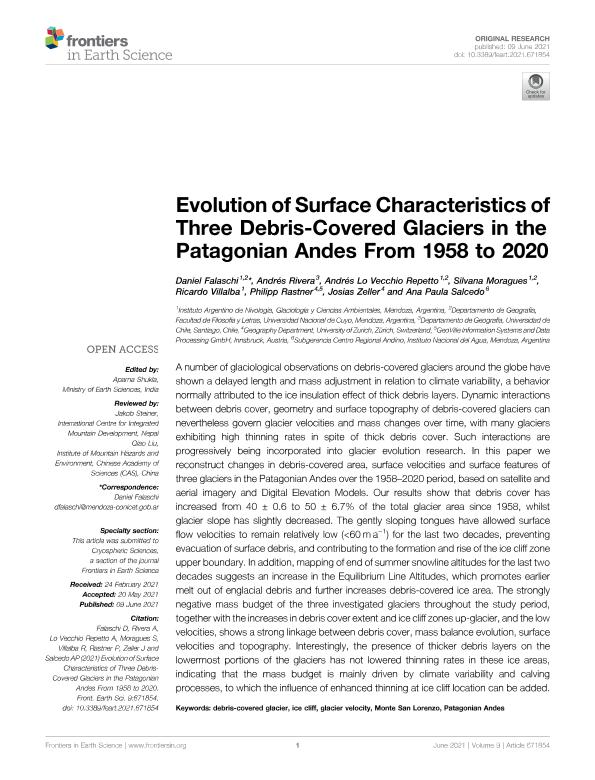Mostrar el registro sencillo del ítem
dc.contributor.author
Falaschi, Daniel

dc.contributor.author
Rivera, Andrés

dc.contributor.author
Lo Vecchio Repetto, Andrés

dc.contributor.author
Moragues, Silvana Noelia

dc.contributor.author
Villalba, Ricardo

dc.contributor.author
Rastner, Philipp
dc.contributor.author
Zeller, Josias
dc.contributor.author
Salcedo, Ana Paula

dc.date.available
2022-09-30T19:04:48Z
dc.date.issued
2021-06
dc.identifier.citation
Falaschi, Daniel; Rivera, Andrés; Lo Vecchio Repetto, Andrés; Moragues, Silvana Noelia; Villalba, Ricardo; et al.; Evolution of Surface Characteristics of Three Debris-Covered Glaciers in the Patagonian Andes From 1958 to 2020; Frontiers Media; Frontiers in Earth Science; 9; 6-2021; 1-19
dc.identifier.issn
2296-6463
dc.identifier.uri
http://hdl.handle.net/11336/171329
dc.description.abstract
A number of glaciological observations on debris-covered glaciers around the globe have shown a delayed length and mass adjustment in relation to climate variability, a behavior normally attributed to the ice insulation effect of thick debris layers. Dynamic interactions between debris cover, geometry and surface topography of debris-covered glaciers can nevertheless govern glacier velocities and mass changes over time, with many glaciers exhibiting high thinning rates in spite of thick debris cover. Such interactions are progressively being incorporated into glacier evolution research. In this paper we reconstruct changes in debris-covered area, surface velocities and surface features of three glaciers in the Patagonian Andes over the 1958–2020 period, based on satellite and aerial imagery and Digital Elevation Models. Our results show that debris cover has increased from 40 ± 0.6 to 50 ± 6.7% of the total glacier area since 1958, whilst glacier slope has slightly decreased. The gently sloping tongues have allowed surface flow velocities to remain relatively low (<60 m a−1) for the last two decades, preventing evacuation of surface debris, and contributing to the formation and rise of the ice cliff zone upper boundary. In addition, mapping of end of summer snowline altitudes for the last two decades suggests an increase in the Equilibrium Line Altitudes, which promotes earlier melt out of englacial debris and further increases debris-covered ice area. The strongly negative mass budget of the three investigated glaciers throughout the study period, together with the increases in debris cover extent and ice cliff zones up-glacier, and the low velocities, shows a strong linkage between debris cover, mass balance evolution, surface velocities and topography. Interestingly, the presence of thicker debris layers on the lowermost portions of the glaciers has not lowered thinning rates in these ice areas, indicating that the mass budget is mainly driven by climate variability and calving processes, to which the influence of enhanced thinning at ice cliff location can be added.
dc.format
application/pdf
dc.language.iso
eng
dc.publisher
Frontiers Media

dc.rights
info:eu-repo/semantics/openAccess
dc.rights.uri
https://creativecommons.org/licenses/by/2.5/ar/
dc.subject
DEBRIS-COVERED GLACIER
dc.subject
GLACIER VELOCITY
dc.subject
ICE CLIFF
dc.subject
MONTE SAN LORENZO
dc.subject
PATAGONIAN ANDES
dc.subject.classification
Otras Ciencias de la Tierra y relacionadas con el Medio Ambiente

dc.subject.classification
Ciencias de la Tierra y relacionadas con el Medio Ambiente

dc.subject.classification
CIENCIAS NATURALES Y EXACTAS

dc.title
Evolution of Surface Characteristics of Three Debris-Covered Glaciers in the Patagonian Andes From 1958 to 2020
dc.type
info:eu-repo/semantics/article
dc.type
info:ar-repo/semantics/artículo
dc.type
info:eu-repo/semantics/publishedVersion
dc.date.updated
2022-09-19T12:43:15Z
dc.journal.volume
9
dc.journal.pagination
1-19
dc.journal.pais
Suiza

dc.journal.ciudad
Lausana
dc.description.fil
Fil: Falaschi, Daniel. Consejo Nacional de Investigaciones Científicas y Técnicas. Centro Científico Tecnológico Conicet - Mendoza. Instituto Argentino de Nivología, Glaciología y Ciencias Ambientales. Provincia de Mendoza. Instituto Argentino de Nivología, Glaciología y Ciencias Ambientales. Universidad Nacional de Cuyo. Instituto Argentino de Nivología, Glaciología y Ciencias Ambientales; Argentina
dc.description.fil
Fil: Rivera, Andrés. Universidad de Chile; Chile
dc.description.fil
Fil: Lo Vecchio Repetto, Andrés. Consejo Nacional de Investigaciones Científicas y Técnicas. Centro Científico Tecnológico Conicet - Mendoza. Instituto Argentino de Nivología, Glaciología y Ciencias Ambientales. Provincia de Mendoza. Instituto Argentino de Nivología, Glaciología y Ciencias Ambientales. Universidad Nacional de Cuyo. Instituto Argentino de Nivología, Glaciología y Ciencias Ambientales; Argentina
dc.description.fil
Fil: Moragues, Silvana Noelia. Consejo Nacional de Investigaciones Científicas y Técnicas. Centro Científico Tecnológico Conicet - Mendoza. Instituto Argentino de Nivología, Glaciología y Ciencias Ambientales. Provincia de Mendoza. Instituto Argentino de Nivología, Glaciología y Ciencias Ambientales. Universidad Nacional de Cuyo. Instituto Argentino de Nivología, Glaciología y Ciencias Ambientales; Argentina
dc.description.fil
Fil: Villalba, Ricardo. Consejo Nacional de Investigaciones Científicas y Técnicas. Centro Científico Tecnológico Conicet - Mendoza. Instituto Argentino de Nivología, Glaciología y Ciencias Ambientales. Provincia de Mendoza. Instituto Argentino de Nivología, Glaciología y Ciencias Ambientales. Universidad Nacional de Cuyo. Instituto Argentino de Nivología, Glaciología y Ciencias Ambientales; Argentina
dc.description.fil
Fil: Rastner, Philipp. Universitat Zurich; Suiza. GeoVille Information Systems and Data Processing GmbH; Austria
dc.description.fil
Fil: Zeller, Josias. Universitat Zurich; Suiza
dc.description.fil
Fil: Salcedo, Ana Paula. Secretaria de Ambiente y Desarrollo Sustentable de la Nación. Instituto Nacional del Agua y El Ambiente (Mendoza); Argentina
dc.journal.title
Frontiers in Earth Science
dc.relation.alternativeid
info:eu-repo/semantics/altIdentifier/url/https://www.frontiersin.org/articles/10.3389/feart.2021.671854/full
dc.relation.alternativeid
info:eu-repo/semantics/altIdentifier/doi/https://doi.org/10.3389/feart.2021.671854
Archivos asociados
